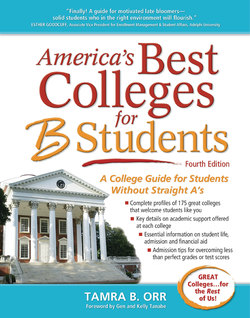Читать книгу America's Best Colleges for B Students - Tamra B. Orr - Страница 47
На сайте Литреса книга снята с продажи.
Putting Words on Paper
ОглавлениеCollege essays are typically 250 to 500 words. That is about one to two pages of typing, double spaced. According to the Common Application (www.commonapp.org), that limit is a guideline because colleges do not actually count the words. They won’t mind if it is a little shorter or longer because quality is far more important than quantity. “College admissions officers are far more concerned that the essay is well written, proofread (not just spell-checked), well thought out, etc. Do not get caught up in the ‘micro’ (words, spacing, font size, color of ink),” states the website. “They are looking for the ‘macro’: does the student write well and what can they learn about this person from his/her essay?” Their website has more helpful information on what you will find on many college application forms.
Once you know the question, sit down and brainstorm possible answers. Just let your mind wander around the topic and write it all down without judgment or self-censorship. When you have run out of ideas, start going through what you have. What looks best? Throw out the things you could only write a paragraph about and keep the ideas that you can build into several pages of examples and facts that support a topic sentence. Look for the ones that make you feel emotional; that probably means they impacted your life in some way. Then choose one.
Now, write out an outline, just like you have done for other papers and reports you’ve done in school. What are the main points you want to cover? What details go under each point? For example, imagine that you have been asked to write about something you have read that was significant to you. Some points you might want to cover include these: Why you chose to read the book, how you felt while reading it, what new perspectives or points of view the author taught you, what questions the material raised in your mind, what you learned from the experience.
Once your outline is done, it is time to write your first draft (and yes, that means there will be second, third and more drafts before you’re done). Do not start your essay with any of the following opening sentences:
My name is Kevin Jones and I …
I was born in Los Angeles, California, and …
My college admissions essay is going to be about …
I am writing this because I really want to go to your college …
This is the story of my life so far …
I am such a great person that you will want to read my story …
My parents, Jean and Jasper Carpenter, first moved …
These are boring lead-ins and you will most likely have lost the reader’s attention in the very first paragraph. Start with something interesting, eye-catching and unique. Grab the admissions officer’s attention by writing something that will make him or her put down that cup of coffee, sit up straight in the chair and want to read what comes next.
Your first draft should be written without worrying about grammar, spelling or punctuation. You want to get your best thoughts down first, without being slowed down by rules. In case you don’t remember the basic structure from endless English classes, you need the minimum of a five-paragraph essay. It should look pretty much like this:
| INTRODUCTION thesis statement |
| BODY: Paragraph 2 support for thesis statement |
| BODY: Paragraph 3 support for thesis statement |
| BODY: Paragraph 4 support for thesis statement |
| CONCLUSION summary of main points |
When you are done, show the first draft to your friends and family. Ask their opinions. Should you give more detail? Was everything clear? Did it represent your personality? Is this how they would have imagined you answering the question? Listen carefully to their feedback so you can use it in your revisions.
Now write a second draft, pulling in any extra details you remembered and keeping others’ comments in mind. This time, fix any spelling, grammar or punctuation errors. Share it with a favorite teacher or your guidance counselor. Get their comments. Go back to the desk. Go through it again, keeping the new feedback in mind. Run spell check (but do not depend on it) and print. You’re ready.
